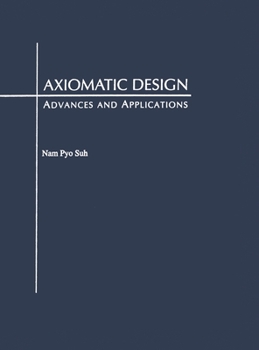Axiomatic Design Mitpsme C
Select Format
Select Condition 
Book Overview
Design education, research, and practice have recently seen considerable evolution as university programs, researchers, journals, and conferences systematize design as a discipline and science. Nam P. Suh's book Axiomatic Design: Advances and Applications contributes to this systematic and scientific base and presents a fresh perspective on design, establishing a rational framework for the discipline. The book follows Suh's successful publication, The Principles of Design (OUP 1990), although the two books are substantially different in both content and approach. The first three chapters of Axiomatic Design cover the fundamental principles of axiomatic design. The following chapters offer a complete treatment of the design of systems, software, materials and materials processing, manufacturing systems, and product design. Suh shows how a scientific and systematic approach to design improves efficiency, productivity, savings, reliability, and quality for industries that currently rely on ad hoc design systems; Axiomatic Design contains the principles and practical knowledge necessary to achieve these improvements. Perfect for senior and graduate design and mechanical engineering students as well as professional engineers, this unique text offers the tools necessary to design with ease and elegance and serves as a stepping-stone in the ever-evolving intellectual science of design. Features - Applies the principles of axiomatic design to a variety of real-life situations including mechanism design, software engineering, and basic business processes - Includes numerous integrated case studies using axiomatic design to solve real-life design challenges - Draws material from consulting cases with industrial firms throughout the world - Requires no prerequisite reading ( The Principles of Design can be read for clarification)
Format:Hardcover
Language:English
ISBN:0195134664
ISBN13:9780195134667
Release Date:May 2001
Publisher:Academic
Length:528 Pages
Weight:2.40 lbs.
Dimensions:1.2" x 7.8" x 9.5"
Customer Reviews
1 rating
What is important here?
Published by Thriftbooks.com User , 21 years ago
One of great emerging ideas in the past 20 years is that there are tools to help in the design of robust products and systems. There are other approaches: TRIZ, QFD and other heuristic-based methods. There are also references to Dr. Taguchi's robust design methods (DFSS). The point is that the author here has made his point - DFSS as applied to multi-requirement products and systems... and that includes just about every product/system we use and need... has an overlooked flaw. Read this book to understand what that flaw is and how to address it.Is the material here ambitious and audacious? Well... yes, wouldn't it be if the author were on to something? I think that the key here is to understand where this information can be immediately used in engineering practice. The principle of design decoupling and Okcam's Razor are not particularly new ideas, but the way that the author is approaching the subject is important. He is trying to get a handle on something that has been to date very heuristically practiced, and often not well executed. If one understands the principles of, for instance, software engineering, it doesn't take long to understand where the author is going with his subject. Suh is a mechanical engineer (MIT), and this fact, in itself, is very surprizing and encouraging. The axioms that Suh present are necessary in order to achieve some sort of order to the discussion. I personally have managed to get past the initial objections to his reuse of certain terms and emphasis on certain axioms. For instance, Suh's principle of "minimum information content" is actually a statement about "less is more" in design from a reliability and design-robustness perspective.Now for potential buyers: understand that there are applications of this method and theory that are extremely powerful and effective. This method has great implications to the field of systems engineering - it ties the SE discipline to something that you can get your hands on. In particular, look to the application of the method to the design of physical systems and their corresponding manufacturing systems. This isn't a trivial or invalid subject.People who need ways to handle complexity and the total system design problem will benefit as will designers of common products. Software and hardware designers can both benefit, although the author uses language that is more recognizable in the realm of mechanical engineering and manufacturing systems. This material will take some time to integrate into your own storehouse of knowledge - so don't rush it. Approach this material with a need in hand, but with the understanding that it will likely modify your view of your discipline. Then you will make use of this material. Note the bibliographies; dig into the applications of this theory. You won't be disappointed in the outcome.






